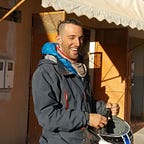Cultured meat and Australia
A couple of weeks ago we cut the ribbon on Vow’s “Factory 1”, giving us the chance to pause and acknowledge what cultured meat could mean for Australia.
Meat is delicious. Whether you choose to eat meat or not, you know it’s bloody good food.
This is why I, and billions of others, eat meat.
And it’s why a staggering 339 million tonnes of meat were eaten globally in 2021, up 5% from 2020.
But meat production is deeply problematic. From land clearing, to water use, to the rising zoonotic disease outbreaks, to the repeated mass culling of diseased animals, our growing appetite for meat is creating increasingly dire problems.
We are shielded from much of this here in Australia. Our meat is world-class in it’s quality, safety, and sensory experience, hence why Australian beef and lamb is proudly displayed on international menus from Singapore to Japan, to China to the US.
Australian beef and lamb are special. They are amongst the most sustainable production practices on the planet, and rightfully, we export a lot of what we produce. Australia exported 1.45 million tonnes of beef and lamb in 2021 alone.
1.45 million tonnes is a lot of meat to export, right?
In 2021 alone the global increase in meat production was a staggering 17 million tonnes. All of Australia’s meat exports were less than 1/10 of just one year of global growth.
We are a nation gifted with abundant space but also vast, empty deserts. We can only use a fraction of this space for high density farming.
Cultured meat and the world
In the past 24 months cultured meat has been recognised around the world as a high-potential food technology.
The US, Australia’s fourth largest export destination for meat, is not just committing to cultured meat, but viewing it as a matter of national security.
Recently, President Biden issued an Executive Order to jumpstart the Sustainable, Safe, and Secure American Bioeconomy, which included a directive for:
“assessing how to use biotechnology and biomanufacturing for food and agriculture innovation… and cultivating alternative food sources.”
In Asia, the story is similar. China, Australia’s third largest export destination, has identified cultured meat in their five-year food plan.
Singapore has a mandate to produce 30% of their food onshore by the end of the decade, for which cultured meat will be pivotal.
We can’t increase our meat production in Australia by 100x or even 10x with farming. We can increase production by embracing new technologies to both export cultured meat produced in Australia and the technologies that enable its production.
We have all the right ingredients for Australia to do this: talent, space, trust of the world, and very robust food safety systems. This is why Vow was founded and is headquarted in Sydney, Australia.
How we do things at Vow
Vow makes cultured meat. We grow animal cells outside of animals to make all the parts of meat we want to eat and nothing else.
But we don’t do this to make what farmers make — we invent entirely new meats that have never existed before: meats that are tastier, more nutritious, more functional, or more exclusive than meat from animals.
We do this because we believe two, simple things:
- The animals our ancestors domesticated aren’t the best possible meat we can produce with new technologies
- Consumers are selfish and will only change their behaviours when the alternative is far better than animal agriculture.
We are preparing to sell our first product and will announce where you can find it very soon.
Cultured meat and Australia
We have all the right ingredients for Australia to be an exporter of both world class meat and cultured meat. We have the necessary ingredients: talent, strong, robust food regulations, and the export market access.
At Vow, we’ve built a world-class team of over sixty Vowzers since our inception in 2019, including more than a dozen who have moved internationally to Sydney to join the team.
Cultured meat should not be seen as a competitor to farming, but rather, a perfect complement. Together, we can sustainably magnify the output of Australian meat to the world 10–100x.
It’s my hope that Australia can become world-leading in both regenerative agriculture and cellular agriculture, exporting the finest foods to the world regardless of how they are made.
